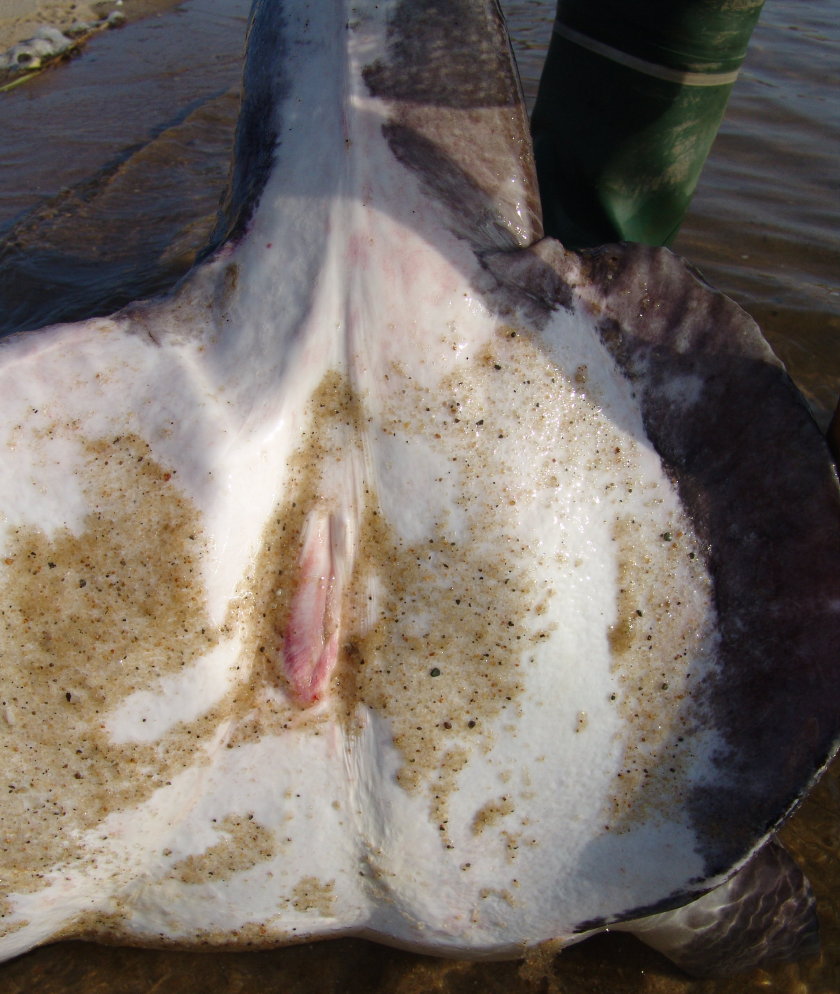Torpedo Ray (Torpedo nobiliana) in Wellfleet Bay
We have uncovered some unusual finds the last few days. A large blue shark, one of the world’s ten most dangerous, came ashore on the tidal flats of Lieutenant Island. A rafter of wild turkeys appeared with traffic-stopping effect along the main Outer Cape highway in Eastham. An exotic ocean sunfish stranded at the end of Shirttail Point in Wellfleet Harbor. And harbor seals seem to have moved in for the fall season.
You might expect that we would be getting used to running into rare specimens. Maybe so, but we were still shocked … thankfully only figuratively … when we ran into a large, female torpedo ray floating off the Wellfleet town landing at Burton Baker Beach. Yes, Virginia, about a mile north of the blue shark. For those who may not be familiar with the torpedo ray, a group within which Don blissfully counted himself until today, this fish is an electric ray that can deliver a 220 volt charge in a short duration burst. (ASIDE: If Don actually had known about torpedo rays and that this strange looking creature was a torpedo ray, he wonders if he would have waded into the water to determine what it was and whether it was alive or dead … even with his pseudo-rubber boots.)
Click Here to View Video in High Quality
Sue Wieber Nourse Measures FemaleTorpedo RayÂ
The torpedo ray is a cartilaginous fish … like sharks and skates. Its shape is a round, flat disk with a relatively short, large caudal fin that has two dorsal fins. While this ray can reach 6 feet long and 200 pounds, most torpedo rays taken from the Atlantic fall in the 75 pound range. It does not have spines or thorns that are characteristic of common skates. Small eyes are set forward and this ray’s color is brownish or purplish on the dorsal (top) surface and white on the ventral (bottom) side.
Brownish Color; Short, Large Caudal Fin with Two Dorsal Fins
Habitat for the nocturnal torpedo ray is benthic (bottom of the sea) where it buries itself in the sand during the day. While described as pelagic, torpedo rays can be found mostly along the continental shelf in water from 10 to 350 meters deep. They are not common in inshore waters. This fish is the only electric ray that is found in the northwest Atlantic Ocean and historic records document torpedo rays in Vineyard Sound, Buzzards Bay and Cape Cod Bay, especially the Provincetown area.
Female Torpedo Ray with Pelvic Fins & No Claspers
This specimen was identified as a female with pelvic fins and no claspers. Factoid: Torpedo ray females bear live young.
Pectoral Fins Guide Stunned Food To Its Protruding Mouth
The torpedo ray has two kidney-shaped electrical organs that make up 20% of its weight and are located on the pectoral fins. They generate a power equivalent to 220 volts that stuns prey with a burst of electric current. Its prey includes flounder, silver hake fish, small sharks such as dogfish, eels, worms and crustaceans. After stunning its prey, the torpedo ray guides food with its pectoral fins toward its protruding mouth for ingestion.
Four Feet Six Inches From Snout to Caudal Fin
We measured this specimen along the spine from the tip of its snout to the trailing edge of its caudal fin. The curved length is four feet six inches. The maximum width across the pectoral fins (along the dorsal surface) is three feet two inches.Â
Caudal Fin Measures One Foot Five Inches Long
The width across her pelvic fins is one foot five inches, the exact same measurement as the length of the caudal fin. The height of the caudal fin is 11 inches. We had no scale that could weigh a creature of this size. So, we used the Don “how much torque does it take to flip this animal” methodology, similar to the technique we employed on the blue shark. His back estimates that the torpedo ray weighed somewhere south of 100 pounds.
Torpedo rays have no significant commercial value today. Once upon a time when Southeast Massachusetts was the OPEC of its day, providing the energy that lit the entire world, liver oil of torpedo rays was considerd equal to the best sperm whale oil for illumination. Some in those days said that torpedo ray oil cured cramps if rubbed externally and stomach ailments when taken internally. We can attest to the fact that the torpedo ray is one awfully oily fish that we had to wrestle into place to take measurements and captured documentary images. (You’re right it was muscus and not oil, but the allusion wouldn’t have worked if we had said “slimy” rather than “oily.” You caught us distorting science to play with words and our only defense is that it’s Guy Fawkes Day, and words are safer to play with than bonfires … and barrels of gunpowder. “Remember, remember, the Fifth of November.”)
Do you remember just a few weeks ago when swimming in Wellfleet Bay seemed like a safe pasttime? Those were the halcyon days of our innocence. Remember our friend Hamlet, the Prince of Denmark, “There are more things in heaven and earth, Horatio, Than are dreamt of in your philosophy.”
And, yes, we did vote yesterday. Hope all our readers did, too.







[…] Turtle Journal Saving the World, One Turtle at a Time « Shocking Discovery! Torpedo Ray in Wellfleet Bay […]
[…] in Turtle Journal about the first three torpedo rays that washed up on Cape Cod beaches. (See Shocking Discovery! Torpedo Ray in Wellfleet Bay and Torpedoes Los!). Since our last posting, two more torpedo ray deaths have been confirmed: […]
[…] torpedo ray sightings of the fall season. You may recall that we had reported previously about Shocking Discovery! Torpedo Ray in Wellfleet Bay, Torpedoes Los!, and More Torpedo Rays Raise More Questions. Today’s reports add to the […]
[…] At Burton Baker Beach off Indian Neck, where Turtle Journal documented the first torpedo ray in Shocking Discovery! Torpedo Ray in Wellfleet Bay in early November, floes have buried the shoreline and covered jetties like vanilla icing on […]